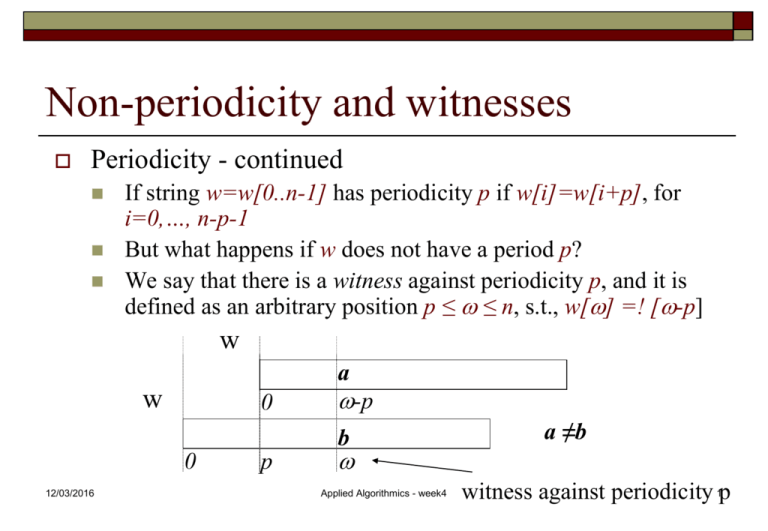P 1
advertisement

Non-periodicity and witnesses
Periodicity - continued
If string w=w[0..n-1] has periodicity p if w[i]=w[i+p], for
i=0,…, n-p-1
But what happens if w does not have a period p?
We say that there is a witness against periodicity p, and it is
defined as an arbitrary position p ≤ ≤ n, s.t., w[] =! [-p]
w
a
w
0
-p
b
0
12/03/2016
p
Applied Algorithmics - week4
a ≠b
witness against periodicity 1p
Dueling via witnesses
If pattern P has no period p, then comparing any two
positions i and i+p in text T we can eliminate at least one
of them as an occurrence of P
P
a
P
0
-p
b
0
T
p
a ≠b
witness against periodicity p
x
i
12/03/2016
i+p
i+
if x≠a eliminate position i+p
Applied Algorithmics - week4 if x≠b eliminate position i
2
Pattern matching via duels
Assume that pattern P is non-periodic, i.e., the shortest
period of P is longer than m/2 (we will deal with periodic
case later)
Split the whole text T into consecutive segments Si, for
i=0..2n/m, of size m/2 each.
In each segment Si eliminate all (but at most one)
occurrences using < m/2 duels
Test the remaining 2n/m occurrences test naively
The total cost of dueling and the final test is O(n)
12/03/2016
Applied Algorithmics - week4
3
Pattern matching via duels
The search stage is preceded by pattern
preprocessing when the witness is computed for
every non-period in pattern P
The witnesses can be computed on the basis of
KMP failure function in linear O(m) time
Theorem: The pattern matching via duels is
performed in time O(n+m) and memory O(m)
12/03/2016
Applied Algorithmics - week4
4
Pattern matching via duels
One of the greatest advantages of pattern
matching by duels is that the elimination of
pattern occurrences can be done in many segments
of the text parallel
And indeed, the idea of duels (extended by
deterministic sampling method) provides tools for
optimal pattern matching in 2d-meshes, PRAMs,
and hyper-cubes.
12/03/2016
Applied Algorithmics - week4
5
Parallel Random Access Machine
Parallel Random Access Machine (PRAM) is a
system of enumerated (uniform) processors that
communicate with each other and perform various
algorithmic tasks with a help of shared memory
In simple words PRAM is a regular RAM
(simplified model of standard PC) in which
instead of one we have a number of processors
with the same computational power.
12/03/2016
Applied Algorithmics - week4
6
Parallel Random Access Machine
1
2
3
n
There are several sub-models of PRAM that differentiate
according to the memory access protocols
12/03/2016
Applied Algorithmics - week4
7
PRAM sub-models
EREW - exclusive read / exclusive write
CREW - concurrent read / exclusive write
Two (or more) processors can never read from or write to the
same memory cell simultaneously
Processors can read from though cannot write to the same
memory cell simultaneously
CRCW - concurrent read / concurrent write
12/03/2016
Processors can both read from and write to the same memory
cell simultaneously
It is often assumed that in case of concurrent write an arbitrary
value is written into the memory cell
Applied Algorithmics - week4
8
PRAM complexity measures
The following measures are used:
Time complexity
Space complexity
Work which is defined as multiplication of the time and the
number of processors used to solve the problem
In case of PRAM we are mostly interested in the design of
parallel algorithms whose time complexity is bounded by
O(logcn) and work is comparable with the time complexity
of the most efficient sequential algorithms
12/03/2016
Applied Algorithmics - week4
9
Parallel pattern matching in time O(log m)
Reduce the number of occurrences to 2n/m
for j=1 to log m -1 do
for i=1 to n/2j in-parallel do
Processor Pi reduces (using one duel) the number
occurrences in segment P[(i-1)2j..i2j-1] to one
Test naively all remaining pattern occurrences
for i=1 to n in-parallel do
processors with index i = k·m/2..(k+1)·(m/2) -1 test naively single
remaining occurrence in segment k·m/2..(k+1)·(m/2) -1
12/03/2016
Applied Algorithmics - week4
10
Parallel pattern matching
The algorithm uses:
O(log m) rounds (time)
O(n) processors and O(n+m) memory
O(n·log m) work (which is non-linear! I.e, non-optimal)
The work can be reduced to O(n)
12/03/2016
In each consecutive text segment of length log m use one
processor to reduce the number of occurrences to one
Later apply non-optimal algorithm on at most n/log m
remaining pattern occurrences
Applied Algorithmics - week4
11
Pattern preprocessing
One can prove that pattern preprocessing
(computation of witnesses) in all PRAM submodels can be done in optimal time O(log m) and
work O(m).
The preprocessing is based on non-trivial pseudoperiod method.
Theorem: Parallel pattern matching can be done
in optimal time O(log m) and work O(n+m).
12/03/2016
Applied Algorithmics - week4
12
Parallel pattern matching in O(1) time
In the most powerful PRAM sub-model CRCW
the search stage can be performed in O(1) time
The search is based on the notion of deterministic
sample, which is a small collection of witnesses
m/2
The only occurrence of P
in text segment of size m/2
12/03/2016
s1
s2
sk
s1
s2
sk
Applied Algorithmics - week4
k≤log m
13
Parallel pattern matching in O(1) time
The search stage on CRCW PRAM can be done in O(1)
time on O(n·log m) processors as follows
1) Each position in text T is tested for the occurrence of
deterministic sample using O(log m) processors
2) In each segment of size m/2 use m/2 processors to mark
the first and the last occurrence of the deterministic sample
(all other occurrences can be ignored)
3) Test marked occurrences naively using O(n) processors
All 3 steps can be performed in O(1) time
12/03/2016
Applied Algorithmics - week4
14
Parallel pattern matching in O(1) time
The search stage in pattern matching based on
deterministic sample can be tuned to work in
optimal time O(1) and work O(n).
The search stage is preceded by pattern
preprocessing in optimal time O(loglog m) and
work O(m).
There exists O(1) time parallel pattern matching
algorithm with O(1) expected preprocessing time
12/03/2016
Applied Algorithmics - week4
15
Pattern matching in small extra space
Note that one can use the deterministic sample to
implement sequential pattern matching that works
in O(n) time and O(log m) extra space.
In fact, one can reduce the extra space to O(1) and
still keep the linear O(n) pattern search time.
12/03/2016
Applied Algorithmics - week4
16
Pattern matching with “don’t care” symbols
In some applications we are interested in finding patterns
that contain special symbols that match any symbol in the
alphabet
We call these special character “don’t care” symbols
The methods designed for exact string matching do not
work efficiently if the number of “don’t care” symbols in
the pattern is large
Efficient solution to pattern matching with don’t care
symbols is based on fast computation of convolutions
12/03/2016
Applied Algorithmics - week4
17
Pattern matching with “don’t care” symbols
We assume that the strings are built over binary
{0,1} extended by a “don’t care” symbol *
For a larger alphabet A of cardinality n we can
encode each symbol by exactly log n bits
For any pattern P{0,1,*}* we define two strings:
12/03/2016
P0 which is P in which all occurrences of *s are
replaced by 0s, and
P1 which is P in which all occurrences of *s are
replaced by 1s and then all bits are negated
Applied Algorithmics - week4
18
Example of P, P1 and P2
Let pattern P=011*01011**1*0,
Replacing *s with 0s we get a string
P0=01100101100100,
Also after replacing *s with 1s we get a string
01110101111110, and negating all bits we have
P1=10001010000001.
12/03/2016
Applied Algorithmics - week4
19
Pattern matching with “don’t care” symbols
The search for pattern P in text T is replaced by:
1) the search for P0 in text T, and
2) the search for P1 in text T with all bits negated
In both cases for each text position we count the
number of recognized 1s (in case 2 the number of
1s corresponds to the number of 0s) in P
If at any text position the number of matched 1s
and 0s is the same as the number of 1s and 0s in P
the pattern occurrence is found.
12/03/2016
Applied Algorithmics - week4
20
Pattern matching with “don’t care” symbols
Let P=011*01011**1*0, and
Text T=0101010111100101110101110110101110
Then P0=01100101100100, P1=10001010000001.
P0=01100101100100
T=0101010111100101110101110110101110
~T=1010101000011010001010001001010001
P1=10001010000001
12/03/2016
Applied Algorithmics - week4
All 1s are matched
21
The Fast Fourier Transform
But how can we match efficiently all 1s in
patterns P1 and P0?
Rather surprisingly we can translate the matching
of all 1s into the multiplication of large integers
and polynomials
The Fast Fourier Transform is a surprisingly
efficient procedure for multiplying such objects
12/03/2016
Applied Algorithmics - week4
22
The Fast Fourier Transform
A polynomial represented in a coefficient form is described
by a coefficient vector a= [a0, a1, …,an-1] as follows:
The degree of such a polynomial is the largest index of nonzero coefficient ai
A coefficient vector of length n can represent polynomials
of degree n-1
12/03/2016
Applied Algorithmics - week4
23
Multiplication of Polynomials
Fast multiplication of two polynomials p(x)·q(x) as
defined in coefficient form, is seen as follows
Consider p(x)·q(x), where:
n-1
p(x)= i=0
n+m-2
m-1
and q(x)= i=0bi·xi
Then p(x)·q(x)=
ci·xi,
i=0
ai·xi
i
where ci= aj·bi-j, for i= m-1,..,n+m-2
j=i-m+1
The coefficients ci for other values are based on
shorter summations, and we have no interest in them
12/03/2016
Applied Algorithmics - week4
24
Convolutions and FFT
The equation defines a vector c = [c0, c1, …,cn-1],
which we is the convolution of the vectors a and b
If we apply the definition of convolutions directly,
then it will take us time (nm) to multiply the two
polynomials p(x) and q(x)
The Fast Fourier Transform (FFT) algorithm allows
us to perform this multiplication in time O(n log m).
12/03/2016
Applied Algorithmics - week4
25
Convolutions and PM with don’t cares
So what the convolutions have to do with pattern
matching with “don’t care” symbols?
In fact convolutions help a lot. One can interpret
patterns P1R and P0R as well as text(s) T and ~T as
binary coefficients of polynomials of degrees m-1
and n-1 respectively.
And in particular we are interested in convolutions
in polynomials P1R(x)·~T(x) and P0R(x)·T(x)
12/03/2016
Applied Algorithmics - week4
26
Convolutions and PM with don’t cares
Since convolutions of polynomials of degree n
and m can be computed in time O(n·log m) we can
compute convolutions for P1R(x)·T(x) and
P0R(x)·~T(x) in time O(n·log m).
The values of convolutions correspond to the
number of matched 1s and 0s at consecutive
positions in text T
Theorem: The pattern matching with don’t care
symbols can be solved in time O(n·log m).
12/03/2016
Applied Algorithmics - week4
27
Convolutions and PM with don’t cares
Convolutions forming a coefficient at terms with power
i= m-1,..,n+m-2 correspond to number of matched ones
m-1
i
12/03/2016
Applied Algorithmics - week4
1 0
the convolution of these
values will form the
coefficient of term xi
i-m+1
28






